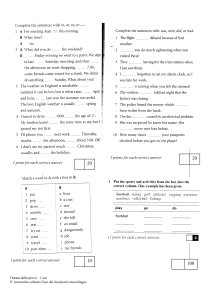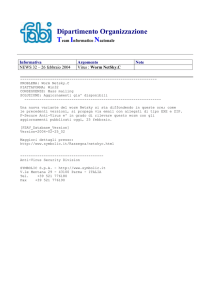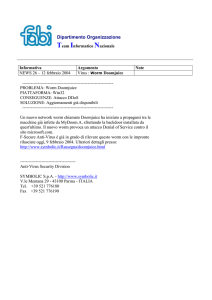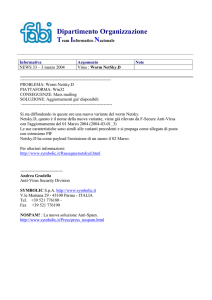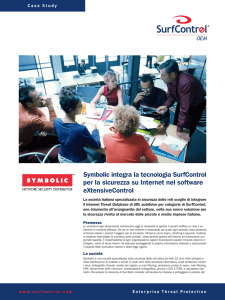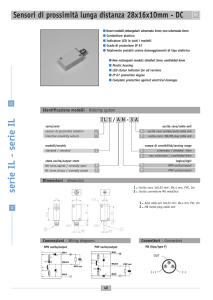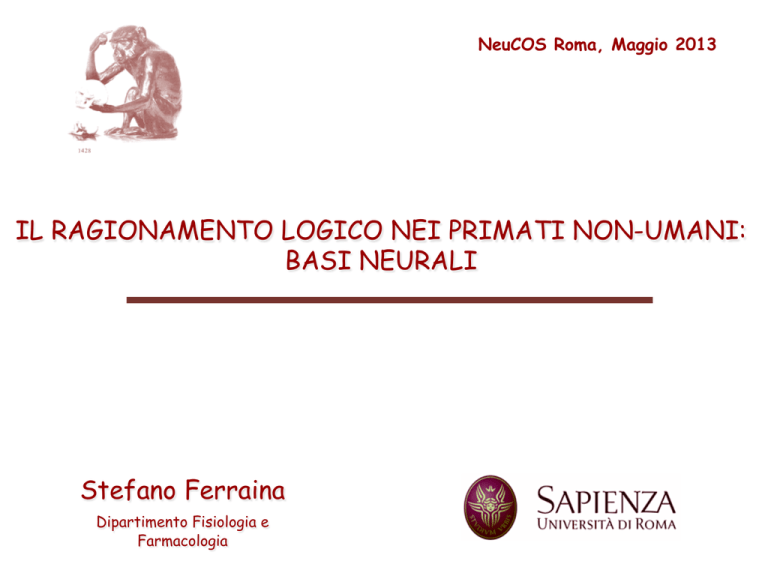
NeuCOS Roma, Maggio 2013
IL RAGIONAMENTO LOGICO NEI PRIMATI NON-UMANI:
BASI NEURALI
Stefano Ferraina
Dipartimento Fisiologia e
Farmacologia
L’apprendimento di relazioni transitive è
importante negli animali, in particolare per quelli
che vivono in gruppi socialmente organizzati
Essere in grado di infererire la propria posizione nella gerarchia di
dominanza può essere vantaggioso in un ambiente dove ‘perdere la
lotta’ può causare danno, difficoltà di accedere alla risorse (cibo)
con possibili serie conseguenze.
Essere in grado di correttamente inferire la
propria posizione non richiede esperienza diretta
Monkey alpha
> alpha members
> non members L’inferenza è una forma di ragionamento logico.
Le basi neurali di questa proprietà sono pressochè sconosciute Inferenza Transitiva (IT)
Ragionamento relazionale in base al quale, una volta note le informazioni di partenza
(premesse), è possibile inferire una conclusione logica
PREMISES
C
A>B
B>C
C>D
B
?D
A
B
D
Un paradigma di Inferenza Transitiva
(da laboratorio…)
- Costruite 80 figure senza significato immediato
- Quotidianamente: sei figure scelte ed ordinate in maniera casuale
- Compito: ‘scoprire’ la sequenza
Apprendimento (fase I)
>
Sequenza Random -> Block 1
>
Block 2
Block design, 20
(10 x 2 posizioni)
trials per coppia >
Block 3
>
Block 4
Correct
>
Block 5
Uncorrect
cue
stimuli
hand position
Correct
KEY PRESS
Holding time
Uncorrect
Response time
La scimmia vede 2 simboli alla volta, scelti tra quelli adiacenti nella lista.
Gli item della lista vengono presentati in maniera sequenziale. La
scimmia impara l’ordine (relativo) della serie per prove-ed-errori. Apprendimento (fase II)
>
>
>
Block 100 trials
>
0,8
0,7
0,6
p(correct)
Intermingled
design,
Tutte le coppie
presentate
0,5
0,4
0,3
0,2
0,1
0
monkey B monkey C
100 trials. Soglia: 65% corretti >
Test – Inferenza
Ranked stimuli
Symbolic
distance
>
>
>
>
>
(1)
(2)
Correct
(3)
Uncorrect
(4)
(5)
cue
stimuli
Correct
hand position
Uncorrect
Holding time
Response time
Durante la fase di test, alla scimmia vengono presentate nuovamente
due figure alla volta ma, in questo caso, anche coppie mai viste prima.
[15 x 2 combinazioni totali] Test – [esempio]
Inferenza Transitiva - performance
Ranked stimuli
Monkey B Symbolic
distance
(1)
(3)
(4)
0,9
P(correct)
(2)
Response time (ms)
1
0,8
0,7
0,6
(5)
1000
900
800
700
600
500
0,5
(1)
(2)
(3)
(4)
(1)
(5)
(2)
(3)
(4)
(5)
Symbolic distance
Symbolic distance
Monkey C 1000
Response time (ms)
1
P(correct)
0,9
0,8
0,7
0,6
Costruzione di una linea mentale
900
800
700
600
500
0,5
(1)
(2)
(3)
(4)
Symbolic distance
(5)
(1)
(2)
(3)
(4)
Symbolic distance
(5)
ing role
criteria
obtaining
average
89%bar
correct
trials.
joystick
(Gravis
Analog Pro) towards the stimulus. The joystick
72
ort the
of the
parietalan
lobe,
and inpercent of
distance
and
each
gaze
positions).
was
kept
aligned
to
subjects’
body
midline
while
a
chin
rest
kept
After
reaching
the
learning
criteria
the
subjects
started
the
73
ht parietal lobe, in solving TI.
theirhad
head
the center of the screen.
The stimuli
presenTo further
study
the organization
of the items in th
testing phase. Each trial of the testing blocks
thealigned
sametodesign
74
tation
and
the
response
detection
were
controlled
by
Matlab
(www.
and time
course as in the learning phase. In these testing trials
“mental line” used to solve TI tasks,
we grouped the late
75
MENTAL
PROCEDURES
matworks.com)
based
routines
created
using
the
Psychophysical
however, subjects had to judge also non-adjacent items of the
cies of motor response according
to the same symbol
76
toolbox (Brainard, 1999).
series, never paired during the learning phase.
Trials with adja77 for the symbolic distanc
distance.
shows
All experimental procedures were
approved Fig.
by the3 local
eth- the results
cent and non-adjacent items were randomly intermingled within
ics board and were performed in accordance
with the
ethical a non 78
ects (two males and eight females; 79!13
1. The figure
displays
linear pattern: the RT wa
the
block.
To
solve
the
task
with
non-adjacent
items,
the
subjects
79
standards laid down in the 1964 Declaration
of
Helsinki.
Inventory) aged between 21 and 31 years
longer for items occupying middle positions in the list an
could relay on the learned relationship between items and, based
80
decreased for items closer to the extremes. This patte
on them, infer the relationship between the items of each pair.
81
has been observed excluding 82
the items A and J from th
In relationship to the hypothesis that the facts for making TI
are integrated in a unified spatial representation, we tested
83
whether the data displayed the distance and size effects, and
84
whether the spatial representation was influenced by changes in
85
gaze position during the execution of the TI. Subjects were re86
quired to perform the TI with the visual stimuli randomly presented
87
either 20° to the left or to the right of body midline (Fig. 1B). The
88
total number of trials of each testing block was equal to 360,
89
including all the 90 possible pairs, with two repetition for each
90
position (up and bottom) of the higher item and eye position (20°
91
left and 20° right). Therefore, each pair of items was presented
92
eight times in each testing block, four times for each left and right
93
fixation conditions. Subjects performed three blocks of testing
94
trials.
95
96
Data analysis
97
98
For each fixation condition in the testing blocks, we calculated the
99
average RT for judging each pair of items. We also sorted the RTs
100
to each item (only correct responses) accordingly to the symbolic
101
distance. To eliminate the anchor effect for the extreme items (A
102
and J) of the series, we excluded from the analysis all the pairs
Fig. 2. Mean reaction time for each symbolic distance in correct te
103
tested with them. In fact, the two items had a different reinforceLa linea
mentale,
sembra
essere
trials. Subjects
were faster
in comparing
items farther
than closer apa
104 was modulated by the ga
ment history, since A was never reinforced and J was always
in the series.
Furthermore,
this
trend
influenzata dall’angolo
disubjects
sguardo
105 when
corresponding to the correct response (Prado et al., 2010; Acuna
position: the reaction time was shorter
performed t
106
(gaze)
et al., 2002a). As a result, since the symbolic distances seven and
task fixating to the left (white dots) than to the right (white square
107 of the mean.
eight contained only comparisons with the anchor items, they
Error bars represent the standard errors
Brunamonti et al., Neuroscience 2010
108
e sequence of events occurring in the Learning (A) and the Test (B) phase of the experimental sessions. Each trial started with
109
Please cite this article in press as: Brunamonti E, et al., Gaze modulates non-propositional reasoning: Further
evidence for spatial
Un supporto all’organizzazione spaziale
delle premesse (Gaze effect)
ot followed by the appearance of a pair of items. Subjects had to maintain the fixation on the dot and move a joystick towards
(Human study)
E’ la distanza simbolica un supporto forte
dell’esistenza di un ragionamento logico?
Strength
5
4
3
2
vs
1
0
(Strength
) - (Strength
) =4
(Strength
) – (Strength
) =1
easier than
vs
Oppure la performance durante il test può essere spiegata dalla storia
della ricompensa (reward) ottenuta per ogni stimolo durante
l’apprendimento ? L’esperimento della catene
Learning chain 2
Learning chain 1
>
Strength
2
>
1
>
Strength
0
Driven by reward
performance
test
Driven by mental distance
vs
vs
2
>
1
0
La performance osservata [anche nell’esperimento
delle catene] supporta l’utilizzo della linea
mentale nei processi di inferenza
900
1
Response time (ms)
p(correct)
0,9
0,8
0,7
800
700
0,6
0,5
600
(1)
(2)
(3)
(4)
Symbolic distance
(5)
(1)
(2)
(3)
(4)
Symbolic distance
(5)
Il serial position effect:
suggerisce strategie di scansione della linea mentale?
Serial position effect
SD 0
SD 1
SD 2
SD 3
SD 4
Gli studi di Imaging suggeriscono un ruolo per la
corteccia parietale posteriore e quella prefrontale
Acuna et al. Cereb. Cortex 2002;12:1312-1321
IFG
<
Sovrapposizione parziale con le aree
che si attivano nei compiti di
confronto di quantità (numeri)
Prado J et al. Cereb. Cortex 2009;20:720-729
Domande
1. E’ possibile dimostrare che i neuroni sono
modulati dal rango acquisito dagli stimoli (alla
fine dell’apprendimemento) ?
2. Sono i neuroni in grado di integrare le
informazioni (rappresentazione distanza
simbolica) ?
Delayed transitive-inference task
1100 Response time (ms)
1 P(correct)
0,9 0,8 0,7 0,6 1000 900 800 700 600 0,5 (1) (2) (3) (4) Symbolic distance
(1) (5) Delay
600-1200 ms
Test trials
(2) (3) (4) Symbolic distance
Correct
(5) Uncorrect
Holding cue
Pair
Correct
Hand position
Uncorrect
Cue ON
Key press
Pair ON
Go Signal
Movement
ON
Response time
Single unit approach
Single unit approach
A
SD 0
SD 1
SD 2
SD 3
SD 0
SD 1
SD 2
SD 3
B
C
D
E
Single unit approach
N= 84
I neuroni di PFc sono
modulati in maniera compatibile con
il serial position effect
n= 24
n= 60
Single unit approach
SD 0
SD 1
SD 2
SD 3
SD 4
La modulazione neurale in PFc non
spiega l’effetto comportamentale
della distanza simbolica
Single unit approach
20% cells recorded on Monkey 1
I neuroni di PFc modulati per il rango
Scaricano, in particolare, quando l’informazione
(l’esperienza) viene usata per costruire nuova informazione
pairs (AB and DE) than for
BC and CD) in all groups
Transitive
05]. Accuracy was
significantly
nts than for NC participants
.05]. No other effects in the
ant.
effects on responses to the training pairs in the second
test block for individuals confused by the probe
inference
in Schizophrenia
pairs. We evaluated
the validity of this concern by
A>B>C>D>E>F
imuli
and Eichenbaum (1997), we
each probe pair to the training
each relevant stimulus compoted ANOVAs that compared BD
and CD training pairs, and AE
and DE training pairs. Training
test block were used in these
he concern that introduction of
the second test block would
for individuals confused by the
ticipants who failed to form a
presentation). This concern will
d following presentation of these
Titoneoneteach
al., Schizophrenia
Resand
2004
Fig. 2. Accuracy
probe pair (AE, BD)
the original
training pairs containing the stimuli comprising each probe pair
(respectively, AB/DE and BC/CD). Error bars are F 1 S.E.M.
Modello del Glutammato sintomi della
Schizofrenia
Inhibitory neuron
Excitatory neuron
NMDAR normal
NMDAR blocked
N-methyl-D-aspartate-receptor (NMDAr) sessions
g/kg ketamine
receptors, the injection of ketamine, a NMDA noncompetitive antagosist, should increase the
Ketamina
antagonista)
variability
related(NMDAr
the computational
evidence and
decrease thepossibili
speed of theeffetti…
integration.
>
(3)
threshold
(1)
threshold
(3)
threshold
(1)
Evidence Integration
(4)
nce
>
>
> >
Selected item
NMDA
NMDA
After ketamine
threshold
Symbolic distance
Before ketamine
Input Input
item 1 item 2
esperimento
cue
stimuli
Correct
hand position
Holding time
Uncorrect
Response time
P (success)
Effetto sulla distanza simbolica
sd 1
sd2
sd3
sd4
Symbolic distance
sd5
Effetto (nel dettaglio)
Conclusioni
Le scimmie imparano rapidamente nuove
informazioni (apparentemente in maniera
indipendente dalla storia del reward)
Le scimmie sembrano usare la linea mentale per
risolvere i compiti di inferenza transitiva
I neuroni di PFc sono modulati dal rango in
maniera compatibile con il ‘serial position effect’
Il dato comportamentale dell’effetto della
distanza simbolica è meno spiegato
La corteccia PFc ‘entra in gioco’ nella fase di
manipolazione delle premesse
NMDAr ha un ruolo nella performance in un task
di tipo TI
.
Grazie a:
Valentina Mione
Fabio Di Bello
Emiliano Brunamonti


